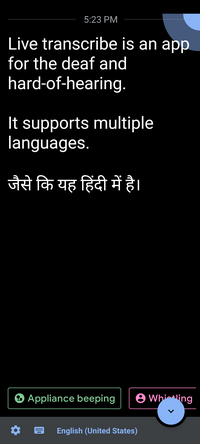|
| |
 A screenshot of Google Live Transcribe running on a
Samsung Galaxy S20 | |
| Developer(s) | Google Research |
|---|---|
| Initial release | February 4, 2019 |
| Stable release | 6.6.602963593
[1]
/ February 5, 2024 |
| Operating system | Android |
| Size | 4mb |
| Type | Accessibility |
| License | Open Source |
| Website |
www |
Live Transcribe is a smartphone application to get realtime captions developed by Google for the Android operating system. Development on the application began in partnership with Gallaudet University. [2] It was publicly released as a free beta for Android 5.0+ on the Google Play Store on February 4, 2019. [3] As of early 2023 it had been downloaded over 500 million times. [4] The app can be installed from an .apk file by sideloading and it will launch, but the actual transcription functionality is disabled, requiring creation of an account with Google.
Development
Researchers Dimitri Kanevsky, Sagar Savla and Chet Gnegy at Google developed the app in collaboration with researchers at Gallaudet University, [5] an American university for the education of the deaf and hard of hearing. The app uses machine learning to generate captions, [6] similar to YouTube's auto-generated captions. [7]
Features
The app uses automatic speech recognition to generate live captions in over 80 languages with varying accuracy. [8] [9] The app, which requires connection to the Internet to function, is available to download on the Google Play Store.
A later update to the app [10] displayed information on sounds such as clapping, laughter, music, applause, and whistling. [11]
In August 2019, Google made the code for Live Transcribe open-source. [12] [13]
In May 2020, the app started supporting transcription in Albanian, Burmese, Estonian, Macedonian, Mongolian, Punjabi, and Uzbek, supporting 70 languages. [14]
In March 2022, the app was updated with support to transcribe offline, without Internet connection, so long as the appropriate language pack has been installed. [15] The offline mode is only available for devices with 6GB of RAM and certain Google Pixel devices.
References
- ^ "Live Transcribe & Notification APKs". APKMirror. Retrieved April 13, 2024.
- ^ "Meet the Deaf Developer Behind Google's Live Transcribe App". 2019-02-07. Retrieved 2021-01-23.
- ^ Dieter Bohn (2019-02-04). "Google Live Transcribe could be a big help for people who are deaf or hard of hearing". TheVerge.
- ^ "Live Transcribe & Notification". Google Play. Retrieved 2023-02-11.
- ^ "As ADA turns 30, tech is just getting started helping people with disabilities". 2020-07-27. Retrieved 2021-01-23.
- ^ "Real-time Continuous Transcription with Live Transcribe". Google AI Blog. Retrieved 2021-02-15.
- ^ "Google's Sagar Savla Built An App That Can Help 466 Million People Who Can't Hear Communicate". Times of India. 2020-01-06. Retrieved 2021-02-15.
- ^ Giridharan, Vignesh (2019-07-15). "Here's how Google is putting AI to work in healthcare, environmental conservation, agriculture and more | Digit". digit.in. Retrieved 2021-02-15.
- ^ Live Transcribe Team (2020-12-08). "Best Practices for Live Transcribe". Medium. Retrieved 2021-02-15.
- ^ Li, Abner (2019-06-03). "Live Transcribe update will recognize laughing, applause". 9to5Google. Retrieved 2021-02-15.
- ^ Li, Abner (2019-05-16). "Android Live Transcribe can detect farts, but it won't (for now)". 9to5Google. Retrieved 2021-02-15.
- ^ "Google open-sources Live Transcribe's speech engine". VentureBeat. 2019-08-16. Retrieved 2021-02-15.
- ^ "Bringing Live Transcribe's Speech Engine to Everyone". Google Open Source Blog. Retrieved 2021-02-15.
- ^ "Accessibility updates that help tech work for everyone". Google. 2020-05-21. Retrieved 2022-10-06.
- ^ "Google adds an offline mode to the Live Transcribe app". XDA. 2022-03-11. Retrieved 2022-10-06.
External links